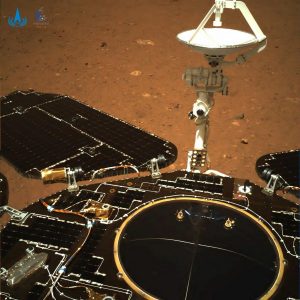[ad_1]

In this photo taken by China’s Zhurong Mars rover and made available by the China National Space Administration (CNSA) on Wednesday, May 19, 2021, the rover’s solar panels and antenna are deployed as the rover sits on its lander on the surface of Mars.
Credit: CNSA via AP
A few days ago, China became the second country to land on the surface of the red planet, Mars. The Chinese spacecraft Tianwen-1 landed a rover, Zhurong, on Mars to study the Martian atmosphere and geology. This is a big scientific and technological achievement for China; previously, only the United States has successfully landed on Mars. (Technically, the Soviet Union made a landing on Mars in 1971, but its Mars lander transmitted radio signals for a mere 14 seconds before it went silent).
Congratulating those who were behind the mission, Chinese President Xi Jinping said, “Thanks to your courage in the face of challenges and pursuit of excellence, China is now among the leading countries in planetary exploration.” Even as this is a significant technological feat for China and a major milestone in humanity’s exploration of space, Beijing’s accomplishment is also a reminder of the revved-up space competition among the major space powers.
China’s Tianwen-1 Mars mission was launched using its heavy-lift carrier rocket, Long March 5, from Wenchang Spacecraft Launch Site in Hainan Province in July 2020. The mission included an orbiter, a lander, and a rover and is reported to have undertaken four trajectory correction maneuvers before entering Martian orbit in February 2021. China is only the sixth to successfully get a probe to Mars, after the U.S., Soviet Union, the European Space Agency, India, and the United Arab Emirates (UAE). The latest of these missions, the UAE’s Hope Probe made it to the Mars orbit in February, too.
The Chinese spacecraft landed on a large plain located in the northern hemisphere of Mars, called the Utopia Planitia. Chinese media reports say that the mission is to “study Mars’ geological structure, soil characteristics and distribution of surface water ice, surface material composition, surface climate and environment, as well as its physical field and internal structure.” The craft has a magnetometer probe to measure the magnetic field on Mars, and a climate station to measure the temperature, pressure, wind speed, and wind direction, which will enable a closer understanding of the Martian surface meteorology.
There are three scientific payloads that will be useful in analyzing the composition of Mars. These include a multispectral camera that will be used for surveying the elements, minerals, and rock types; a Mars surface composition detector to look for hydrated minerals by vaporizing rocks and analyzing their composition; and ground-penetrating radar that can peer deeper into the surface, 10 to 100 meters down into the ground, in order to survey the soil structure and search for water ice. The primary mission is supposed to last around 90 days.
As for China’s future plans, Andrew Jones notes in the National Geographic that the Tianwen-1 mission is an excellent steppingstone for its next Mars mission around 2028, which involves a sample return attempt. China’s ambitious plans also include undertaking a Jupiter probe, with a possible landing on one of its moons, Callisto.
What the Chinese accomplishment also demonstrates is that after several decades, outer space is seeing a return of competition among the great powers. It is difficult not to visualize the beginning of a new space race, with the desire to achieve “firsts” as during the Cold War days between the United States and the Soviet Union. The difference, of course, is that today’s competition is between the U.S. and China, a relatively new player, which is making every effort to prove itself as a scientific and technological powerhouse comparable to the United States. China under Xi is driven by a new sense of techno-nationalism, which is likely to keep the pressure on not just the U.S. to maintain its superiority but also on others to step their space competitiveness. India’s Mars orbiter mission in 2014 was indicative of this competition, too. India wanted to be the first Asian country to complete a successful Mars mission in its first attempt.
China’s Mars mission, as well as its future plans, will drive further competition in the Indo-Pacific and beyond. On the positive side, such competition can lead to greater investment in space science and technology and innovation, which will have additional benefits for all. On the other hand, this will be yet another arena for power politics. It is also likely that China’s achievement will lead to greater collaboration between other major spacefaring nations such as India, the U.S., Australia, and Japan. India is making efforts to step up cooperation with each of its Quad partners bilaterally, but we should not be surprised if these bilateral partnerships coalesce into a Quad space network. Such political competition will likely have negative effects, especially on governing this global common. Coming at a time when global governance of space is already facing myriad challenges, more political competition is not necessarily good news.
[ad_2]
Source link